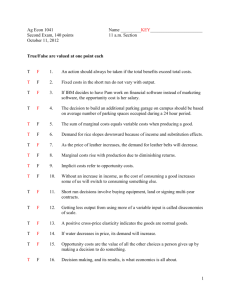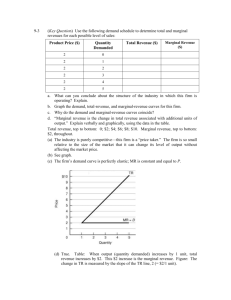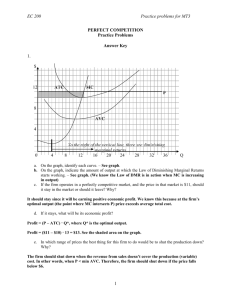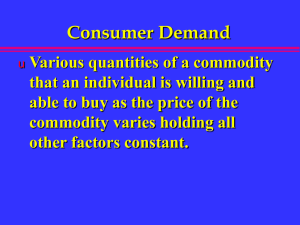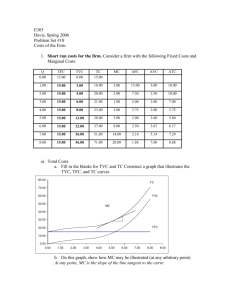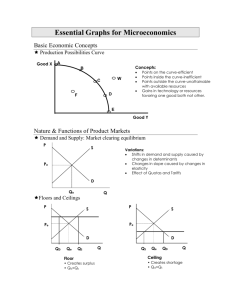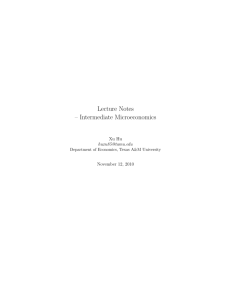ECON 101: Gateman CMP Midterm Review Package
advertisement
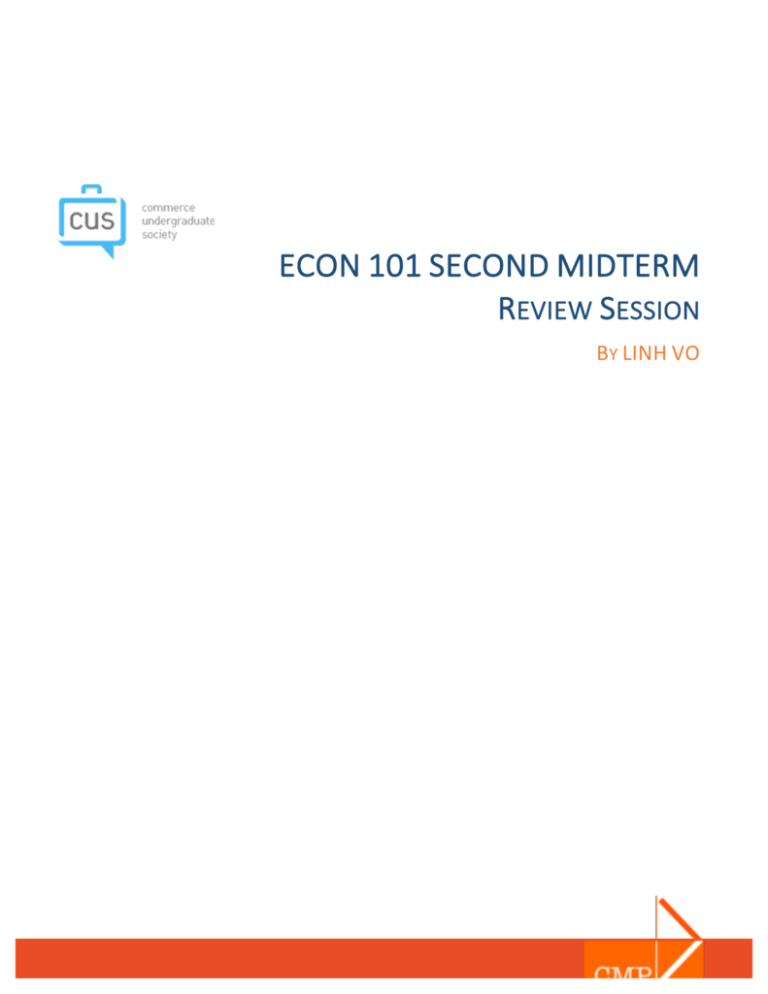
ECON101SECONDMIDTERM REVIEWSESSION BYLINHVO 1 “Assume nothing, worship no one, applaud humility” T ABLEOF C ONTENT I. II. III. IV. V. VI. WhoisLinh? Chapter6–ConsumerBehaviour Chapter7-ProducerinShortRun Chapter8–ProducerinLongRun ExtraExercises Tips 2 Aboutmyself - Is a third year student specializing in Accounting - Reason why I chose Accounting: - Loved economics with Gateman Pursue a career in Tax Is Obsessed with puppies Enjoy tutoring, performing traditional dance, and Netflix >>> Shameless plug for Accounting: if you are thinking of going through recruit next year, you can contact me for general information and stories of how I did it. linhvo@alumni.ubc.ca <<< 3 Chapter 6 – Consumer Behaviour – Maximizing Happiness 1) What is marginal utility? Marginal utility is the utility gained when consume ceteris paribus (hold everything else constant). Change in TU/Change in Q = slope of TU of the good, 2) What is law of diminishing marginal utility? Marginal utility will after a certain point when we the goods. 3) A change in the price of a good implies that a. The real income of a person change b. The purchasing power of a person change c. The current combination of goods no longer provide maximum happiness d. The change in opportunity cost of the goods e. All of the above 4) What are normal, giffen, inferior, and ordinary goods? 4 5) What is consumer surplus? The different between the value consumer willing to pay (demand curve) and what they actually pay (the price) 6) What is producer surplus? The different between the total utility that the producer receive (price) and the TU producer willing to accept (supply curve). In short, the profit. 7) What is paradox of value? utility and utility are two different concepts. Just because A is more valuable than B does not imply that additional spending on A is more valuable than additional spending on B. Water is essential for life, and diamond is for decorative purpose only, but diamond is way more expensive than water. This is because water is abundant and diamond is rare. 8) What is the budget line? All possible consumption combinations of two goods given income and the price of two goods. Equation: _________________________(Total expenditure = total income) Solve for slope: QyPy = Y – PxQx 5 Change in real income: a parallel shift of budget line: Eg: Real income double Change in price of the good: rotation of budget line Eg: Price of x increase What if price of both x and y increase? 9) How to maximize utility? 10) Linh is happiest with the number of pizza and juice that she has. All of a sudden, the price of pizza increase. Advise Linh on what to do to be happy again? 6 Chapter 7 – Producer in the Short Run – Maximizing Profit 1) Costs a. Opportunity cost = the value of b. Sunk cost = expense that , so it’s c. Fixed cost = with number of outputs d. Variable cost = with number of outputs e. Average fixed cost = f. Average variable cost = g. Average cost = h. Total cost = i. Marginal variable cost = j. Marginal cost = 2) What is the Law of Diminishing Marginal Product? As added to a , the after a certain point, holding everything else constant. 3) Why MC curve cuts the AVC and ATC at their minimums? When MC is lower than AVC and ATC, AVC and ATC are When MC is higher than AVC and ATC, both are The point where MC cuts is where . . . 4) True or False, Correct if False a. ATC is higher than AVC b. Constant cost happens when ATC is increasing when we increase level of output Q c. Economies of scale happens when ATC is decreasing when we increase level of output Q d. Diseconomies of scale happens when ATC is decreasing when we increase level of output Q e. Capacity is ACmin in the short run 7 f. g. h. i. Normal profit is the cost of taking on risk to open a new business Economic profit = Total Revenue – Total Accounting Cost Short run is when all the inputs vary holding technology constant A firm gains economies of scale when the MC < ATC 5) Linh is running a firm with the TC = 30 + 3Q + 3Q2 a. AC = b. VC = c. AVC = d. MC = e. Capacity = f. Demand curve: Q = 100 – 5P. Find the quantity and price to maximize profit 6) This table shows the production line that produce water bottles K=1 K=2 K=3 a. L=1 L=2 L=3 10 15 19 15 20 30 20 23 40 Does the production line exhibit increasing return to scale? b. Does the law of diminishing marginal return apply to labour? to capital? 8 Chapter 8 – Producer in the long run – No fixed factor 1) How to choose the optimal production level? (Hint: Isoquant = Indifferent curve, Isocost = Budget Line) Isoquant (combination of K and L that produce the same Q – producer’s indifferent curve) slope = Isocost (All possible combinations of capital and labour given the producer’s budget and the costs – producer’s budget line) = Optimal à (similar to maximize utility function) 2) This table shows different combinations of labour and capital that produce 100 water bottles. Combination A B C D MPL 20 10 15 18 MPK 10 20 18 15 a. What is the optimal mix of labour and capital if the wage is $100/person and and capital lease is $200/machine? b. What happens if the capital lease rate reduces to $120? c. What will you advise the company to do when the wage increases? 9 3) Fill in the blank a. Constant return to scale means that when you double the input, you will get the output. b. Increasing return to scale means that when you double the input, you will get the output. c. Decreasing return to scale means that when you double the input, you will get the output. d. efficiency is minimizing quantity of inputs (QL and QK)while producing a given output e. efficiency is minimizing the cost of all inputs (QL * w and QK*r) while producing a given output 4) Distinguish between SRAC and LRAC curves SRAC - The minimum cost per unit at each level of output when at_______________________, and all factor prices are fixed. - SRACmin = ____________ LRAC - The minimum cos per unit at each level of out when ____________ _________, and all factor prices are fixed - LRAC min = ____________ Graph: Costs (per unit) (show increasing/decreasing/constant return to scale, MES, envelope, left of tangency, right of tangency, at tangency, feasible, infeasible and prefer region) 10 Extra Resources - The back of your textbook are Review Exercises with Answer Key. You should try at least the Chapter Review multiple choice and Short Answer Questions. - Past CMP Review: http://cmp.cus.ca/wp-content/uploads/sites/7/2014/10/CMPECON-101.pdf - UBC Wiki - http://wiki.ubc.ca/EconHelp o Consumer Behaviour: http://wiki.ubc.ca/Consumer_Behaviour o Producer Cost: http://wiki.ubc.ca/Cost_of_Production IF ALL FAIL, TRY THIS: Anyway, 11

